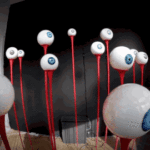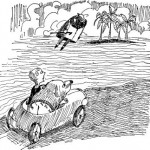I considered doing a Dead Space 2 review, but I don't have much to say in review of the game. It's a good solid play with little that's innovative but plenty to enjoy. Yup, that's about it. You should go play it now.
By integrating choice and multiple user-controlled view-points into the game, Dead Space 2 provides a refreshing alternative to traditional video game cutscenes.
In the extraordinarily crowded field of video games, many seek attention through cut scenes of increasing complexity or realism. I found it somewhat ironic then that Dead Space’s particular unique treatment of cutscenes was mostly ignored.
Despite increasing complexity, user interactions with cut scenes have been pretty limited. You have two choices with a rare third. Choice 1: Skip. Choice 2: Watch. Then some games, oddly, allow you to fast-forward through them.
As a result, video game players and participants in video media in general tend to present two types of video. “You can skip this” or “you are not allowed to skip this.” Video games, television, web videos, heck, video advertising in general all subscribe to this binary choice.
The problem is perspective. For almost all video engagements, only one point of perspective is presented and one line of narrative: the whole of the screen and its single focus. Despite our allegiance to single viewpoint video the technology (starting with Picture-in-Picture TV) to support doing otherwise as a choice for the participant has existed for a while. Admittedly, it was much more difficult for video games to do until recently. However, this is not really an excuse for the sad state of video game cutscenes.
There are any number of problems that could be brought up with video game cutscenes, their ever-increasing length, their sometimes division from the actual content of the game, their complete nonsensicalness. My biggest problem with cutscenes is how designers like to dangle them as a reward for playing the game. I have a problem with the idea that the reward for fun interaction with a game is to have to sit still and listen to the game explain itself via gussied up old media. But if not this, than what?
I think that the Dead Space series provides an answer.
If you are not already familiar with it, in addition to standard cutscenes, Dead Space 1 and 2 provide character-focused videos by projecting them from the main character’s suit, producing a small in-game screen at a locked position and angle from the character, though not the camera. In the game’s universe these are usually produced by some sort of recording device built into the same arm that holds the projection device.
These cutscenes can be viewed at multiple angles by rotating the camera around the character. In addition, there are a few instances where you can also see the character who is projecting to you while watching a close up of their faces on the closer projection.
How Dead Space could revolutionize in-game video.
Notably, Dead Space offers you a half-way point between the standard binary cutscene choice for these events. While walking through the deadly space colony, if you extend your arm to aim your weapon, and choose to exhibit some extra caution while climbing through undead monster territory, the visual portion of the video disappears, leaving only the audio. Presumably because you wouldn’t want to be distracted while shooting something by a talking head.
This is an alternative even to the in-game videos that are standard to RTS games or the slowing down of action for a video or audio briefing done in Gears of War or Vanquish. In an action game with a focus on building fear, forcing the players to make a choice allows them to build more of themselves into the character. It also creates an opportunity to show the inherent risk in the environment.
Giving participants an alternative to watch-or-skip cutscenes is a valuable contribution in and of itself. One that, alone, could have some applications outside of video games. Just as an example beyond the voice-over, short audio advertisements could play in scenes for a TV show. I’d prefer that to some of the more blatant product placement. Another possibility would allow you to choose audio only ads, since most of us are paying attention to another screen anyway.
Even more interesting are the sequences which allow you to view a character from a distance while speaking to them on their wrist-video-thing. In the game, these are often used to build drama. There are situations where you are tantalizingly close to someone but for some reason unable to help.
In situations like these, there is more tension than even in a cutscene of the same situation, because there is increased player agency that can’t be used to alter events. If the game was slightly better written, you might even want to turn off the video, simply to not see what might happen next to a character. There is serious potential for tension. Even when the character on the other side of the screen isn’t right next door, there is a greater sense of wanting to reach into the screen and help. It’s the sort of juxtaposition thing that creates participant tension to begin with, and that tension is only increased by remaining in control of your character the whole time.
When provided with multiple perspectives on the same action, it gives both the event and characters more depth. It allows you to get a close up of the character’s reaction to battle while allowing you to still see the whole of the action. It’s a great tool for humanizing Dead Space 2’s characters, particularly Ellie and Stross who move with the virtual camera and while they talk in a way to give them a certain veracity.
Other applications.
Giving the participant more control over these types of actions is always a good thing. Especially in video games, where cutscenes are a splinter in the paw of many intelligent gamers. It doesn’t have to be a holocomm, (even to do multiple viewpoints) it could be a video phone, video integrated into the background or similar applications.
Beyond that, multiple user-selectable camera angles accessed simultaneously could be the opiate for the increasingly disengaged TV-viewing masses. Getting the film would be easy, even live, most directors film more than one angle simultaneously anyway. It might be especially applicable in reality shows in closed environments, where viewers long for greater and closer contact with the subjects. In a world of DVD extras and online broadcasting, this could be a great incentive for watching live TV.
As for method, the picture-in-picture option still holds serious possibilities, imagine if you had whole channels of related narratives for each TV show you watched and you could view them at the same time as the main narrative on the screen. If you wanted to go a little crazy, you could even try it 24-style, with users selecting multiple viewpoints to watch important events from and able to switch through a larger set.
It’s the sort of universe depth that audiences go crazy for.
Web users could play with YouTube videos, stacking them next to each other and allowing users to select multiple videos to view together.
Indeed, depth is the name of the game here. As a general rule, giving your participants multiple windows into the universe’s action increases engagement.






























